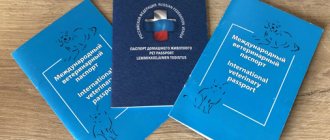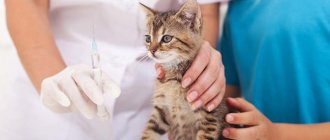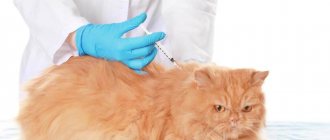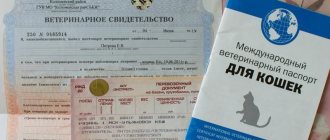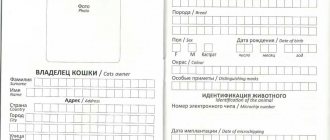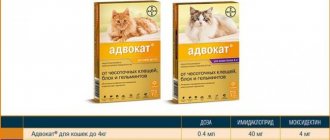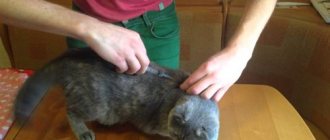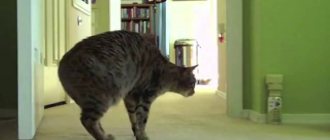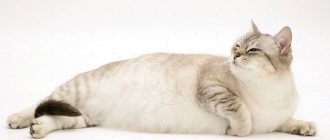A passport for a cat is a document that owners need to travel and move with an animal to a new place of residence outside the territory of the Russian Federation or simply monitor the pet’s health and keep track of whether vaccinations are up to date.
Many countries require this document when traveling abroad. Without a veterinary certificate, a cat is prohibited from entering the territory of the state.
Where do you get your passport?
A veterinary passport is issued at a veterinary clinic and filled out by a veterinarian.
This is usually done during the cat's primary vaccination. In the right places, the passport contains stamps of the medical institution and canceled stickers corresponding to a particular vaccination.
All seals are certified by the doctor’s signature. This is an important point, since without these marks the passport is considered invalid.
Sample of filling out a veterinary passport for a cat. The date of vaccination is entered, a sticker from the vaccine is affixed, a signature and seal of the veterinary clinic are affixed
What is the value of a veterinary passport?
Unfortunately, not everyone understands why a veterinary passport is needed for a dog, cat, ferret or rabbit. And it’s even more difficult to imagine how it can save you from possible lawsuits.
There are only 3 reasons to obtain a veterinary passport:
- This document makes it possible to monitor the health of your pet. Namely: know the exact dates of vaccinations, various treatments against parasites and operations performed. It's comfortable. It is unlikely that you circle the required dates in a red circle on the calendar and then store the torn pages as an archive. But once every six months it won’t be difficult to look into the treasured book.
- An international veterinary passport will allow you and your pet to be anywhere in the world. With the help of a correctly executed document, there are no problems in obtaining the necessary certificates for the export of an animal. And if it seems to you that you will never go anywhere with your dog or cat, believe me, there are different cases.
- And here is the third reason, about which there are so few words. Animals are animals, and no matter how gentle and affectionate your pet is, there will always be a provocateur for an aggressive reaction. And this will not mean at all that your dog or cat is solely to blame.
Most often, animals are simply trying to protect themselves or their offspring. And there can be quite a few provocateurs for aggression - often these are children who do not yet know how to properly treat our smaller brothers, as well as people who do not like four-legged animals or are terribly afraid of them. In this case, biochemical reactions play an important role, due to which complete antipathy arises between a person and a particular animal.
“Bitten by a dog”, “bitten by a cat” are some of the common reasons why people go to emergency rooms. We sincerely hope that you never have to literally “tear” your dog away from a person or another dog. But if this happens, show respect and first apologize. We are sure that you are a prudent and sensible person who will not blame anyone except yourself and your pet for this situation. They can bite anytime and anywhere, including you or your animal - that’s life. There is no need to make a scandal during such a stressful situation - emotions will easily flare up from any spoken word.
In addition to apologizing, you should immediately offer to provide assistance to the victim and provide your pet’s veterinary passport. If your animal has received all the necessary vaccinations, including vaccination against rabies, then you give the victim the opportunity not to torment himself with the question - is there a risk of contracting rabies or not? In this case, the risk of contracting a fatal viral disease is practically absent.
In any case, final conclusions can be drawn only after a general examination of the animal by a veterinarian and if there is a note in the veterinary passport about the vaccination. Without official confirmation that your pet has received a rabies vaccine, you doom the person to specialized medical treatment.
In addition, the victim may sue you, where he will have to prove that you did not deliberately set your dog on this citizen and that in no case did you want to be a participant in the spread of a dangerous viral infection. Believe me, there are no such lawsuits.
Do not think that this can bypass you - anyone can be a victim, including yourself. At least now you know that there is a very important document - a veterinary passport, which, together with your respect for the victim, will help eliminate unpleasant consequences in the future.
What is indicated in the passport?
The veterinary passport contains the following data:
— information about the animal’s vaccination (name of the vaccine, its serial number, date of vaccination, name of the doctor);
— data on helminthic infestation: its prevention or treatment (name of the antihelminthic drug, its dose, date);
— information about measures against ticks and fleas (name of the product, its dose, date);
— data on surgical operations (nature of the operation, name of the doctor);
— information about the cat’s reproductive indicators (date of mating, estrus, number of kittens, date of birth);
— data on possible diagnostic measures;
— a note about the introduction of an electronic chip (if any) (place and number of implantation, date);
— information about its owner;
— information about the veterinary clinic where the cat was registered and the name of the doctor;
— general information about the animal:
- animal photo,
- breed, color,
- type of wool,
- nickname,
- year of birth.
Sample of filling out a veterinary passport for a cat
I lost my veterinary passport, what should I do?
If you have lost your cat's ID, you need to try to remember the month of the last vaccination. Any clinic stores information about vaccinations, so you can easily restore all data.
But it is worth keeping in mind that vaccine stickers that are pasted during vaccination will not be given to you just like that, so we advise you to check the availability of the certificate in advance.
If you cannot remember the approximate date of vaccinations, you will have to go through them again and get a new certificate. Don't worry, this will not harm the animal's health.
How to make a passport for a cat?
It is very simple to obtain a veterinary passport for your cat.
All you need to do is choose a licensed veterinary clinic, come there with your animal and bring with you all the necessary certificates about previous vaccinations and tests.
If you plan to travel abroad with your cat, you will need to vaccinate it against rabies and other infections at least 30 days before.
Also, many clinics practice issuing veterinary passports with a doctor calling at home. This is more convenient, since the animal will not experience stress from visiting an unfamiliar place or a long journey.
How to properly prepare a document
There is no uniform form of veterinary passport on the territory of the Russian Federation. So before you get one, think about your pet's future. If you have no intention of taking it abroad, then any passport form will do. An international passport will be required when transporting a cat to another country. The names of the sections in it are translated into English, and on some forms - into one or two more languages.
International veterinary passport form for your cat
Moreover, in EU countries there is a requirement for animal passports - information must also be written in Latin letters with a line after the Cyrillic alphabet. But you can purchase a form in which there are two lines in each column: you fill out the first in Cyrillic, the second in Latin. The passport can be universal for any animal, or it can be purely for cats. If there is a possibility of mating with a purebred partner or the participation of a cat in exhibitions, you need to fill out all the required fields of the document as carefully and clearly as possible, and paste in a photo of the animal. In these cases, a passport is needed to process various documents and certify the breed, health and reproductive ability. But if the pet lives in your home just “for the soul”, then the veterinary passport serves as a medical card, and you will not have to present it anywhere except a veterinary hospital.
How to fill out owner information correctly
The passport contains several columns about the owner of the animal. This is necessary in order to include the new owner of the cat when selling or donating. Sometimes the document has a separate column “breeder”, where his data is entered. If there is no such field, information about the breeder is entered in the “owner” field. Then the person, when purchasing a kitten, lists himself as the second owner.
You can fill out the column about the cat's owner yourself
How to enter information about a cat correctly
The first column “photo” is optional. But if you decide to paste a photo of your pet, then wait until he is one year old. Information about the pet must be written down as clearly as possible. The animal's name is written with a capital letter. It is copied from the breeder’s metrics or invented by themselves. If you know the cat's breed, write down its exact name. For a purebred cat, indicate “mixed breed.” With color, everything is a little more complicated. If you did not take the kitten from a breeder, or he did not indicate the coat color in the passport, you will have to check the color chart. You can write down the white and black colors yourself; it is better to clarify the remaining shades or spotting. Also indicate the type of coat - shorthair, semi-longhair or longhair. You can indicate an approximate date of birth if you do not know the exact one. The gender of the animal can be indicated “Male/Female”, then underline what is necessary. Otherwise, write Male if you have a cat or Female if you have a cat. You cannot write the gender of an animal with the words “female”, “male”, “male”, “female” or in any other way. Some passports have a column “special o. Features of the color or body structure of the animal are recorded there. For example, the absence of an ear, a white spot on a paw, or a curvature of a vertebra in the tail.
The “cat identification” section is filled out by a veterinarian in case of microchipping or tattooing. The date of the procedure, number and location of the microchip or tattoo must be indicated.
In the section where the cat is described, fill in all required fields!
Features of filling out data on animal registration and vaccination
Information about registering a cat in a veterinary clinic is filled out by a veterinarian. If you purchased an adult animal, you need to mark it within a month. Kittens are usually registered for their first vaccination at 2–3 months of age. Information about vaccinations is also included in the cat’s passport by the veterinarian after vaccination. There must be a date, a doctor’s signature and a stamp from the institution. A label from the vaccine ampoule is also affixed to the passport. The veterinary passport has separate columns for vaccinations against rabies and viral diseases.
But keep in mind that if you yourself know how to give injections to a cat and decide to buy the vaccine yourself, then such a vaccination is considered invalid. The vaccination record must be certified by the seal of a veterinary clinic, otherwise it will be impossible to obtain a veterinary certificate or certificate for the animal. This is exactly the situation that happened to my sister: she urgently needed to go to another city, and she vaccinated the cat herself. And I couldn’t get a veterinary certificate to transport an animal on the train! We had to urgently look for a shelter for the pet for two weeks, since in order to obtain a certificate it was necessary to vaccinate the cat again and wait 30 days.
Vaccination entries are the most important in a veterinary passport
How much does it cost to get a passport for a cat? (prices 2018)
Depending on the conditions for obtaining a veterinary passport for a cat (a personal visit to a doctor or a house call), its cost may vary. A blank veterinary passport form costs from 35 to 100 rubles (depending on the clinic).
The price of obtaining a veterinary passport in Moscow depends on the urgency.
At the beginning of 2022:
- urgent registration without queues in 2-3 hours will cost 3400 rubles. ;
- non-urgent processing – 2500 rub .
If you still have questions, watch this video. Here, the veterinarian talks in detail about how to independently fill out a veterinary passport for cats and dogs.
What documents are desirable to have for a dog and a cat?
When buying a puppy or kitten, you can get the first documents from the breeder - this is the purchase and sale agreement and the animal's registration. However, not every breeder can issue such papers.
In Russia, any person can breed animals, but few of them register their nursery as an official organization. Thus, some sellers simply cannot have a formalized purchase and sale agreement and pet registration.
But if you purchased a purebred animal in an official nursery (breeding), then you will definitely be given all the necessary documents. In this case, for the further possibility of your pet’s participation in exhibitions and breeding, you can also complete a pedigree a little later.
But not everyone wants to buy a puppy or kitten. Often our new friends come to us from the street. And, of course, you won’t find any contracts or metrics with them, and it will be simply impossible to draw up these documents from anyone.
In this case, only one document will be in the foreground - the veterinary passport.
Who fills out the veterinary passport and how?
The owner can enter information about himself and the pet, or the doctor can enter information about himself and the pet when registering the animal before vaccination.
Fields for self-entering data:
OWNER OF ANIMAL
"FULL NAME. / Name” – the owner indicates the full name, surname.
“Address” – if the kitten was registered to a breeder, then after purchase the owner changes all the breeder’s information to his own.
DESCRIPTION OF ANIMAL
“Type of animal” – if the cat is purebred and has a metric, then it is filled in as in the pedigree.
For example, like here for the sphinx:
“Pet's name” - is given according to the metric; for outbreds - their own nickname.
“Breed” – for outbred animals it is written “mixed breed” or “mongrel”.
“Date of birth” – if it is not known exactly, it is indicated approximately.
“Gender / Sex” – one of the options: “female”, “male” or tick “v”.
“Pet photo” – paste any photo without printing.
“Color” – write it as in the metric, or make a description yourself.
“Special signs / Distinguishing marks” – if any.
Document appearance
In Russia, a veterinary passport for a cat does not have one set form and can be different. The basis here is not the appearance, but its internal content. However, there is an exception in certain regions of the country. For example, in St. Petersburg, strict veterinary rules have been established. The passport you can make there will look exactly like this:
In Russia, a veterinary passport for a cat does not have one set form and can be different.
Keep in mind that it will be difficult to get abroad with this document, since there is no place for a photograph of the pet, and the columns are printed only in Russian and English. This is a very serious reason to refuse your travel abroad.
Before you get a passport for your cat, thoroughly study all the rules for exporting an animal, as well as the region in which you will be drawing up the document.
Microchipping a cat
A good method that will prove that the cat is yours and no one else’s is microchipping. To do this, an electronic chip or simply a carrier is sewn under your pet’s skin. However, this technique is mainly used by owners of purebred animal species. This is a kind of electronic passport, which can be used to restore all data if suddenly the paper form is lost or something happens to it.
Mostly owners of purebred animal species resort to microchipping.
But keep in mind that chipping itself is an expensive pleasure and not everyone can afford it. Typically, the cost of such a procedure ranges from 600 to 1500 rubles.
How much does registration cost?
The following factors influence how much a veterinary passport for a cat costs:
- conditions for registration: calling a veterinarian at home or visiting a clinic (private or public);
- urgency of production;
- carried out to complete the procedure.
The form itself can be purchased at almost any pet store or veterinary clinic at a price ranging from 35-100 rubles. In fact, the cost of obtaining a veterinary passport will correspond to the cost of vaccinating your pet, but if you need to issue an urgent option, this figure can increase significantly.
Which animals can and cannot be transported on an airplane?
Typically, pet dogs and cats fly on airplanes without any problems. But some airlines prohibit the carriage of dogs with a flattened muzzle , such as pugs, bulldogs, boxers, Shih Tzus and Pekingese. Due to the structure of their nose, they can suffocate during the flight. For the same reason, cats of brachycephalic breeds with upturned noses (Burmese, Persian, exotic, Himalayan) are denied flights, but such a ban is less common.
Not all airlines allow you to take ferrets, hares, rabbits, turtles and birds with you, but you can still find a carrier. It’s much more difficult with rodents: almost no one carries them either in the cabin or in luggage. Among the rare carriers that are loyal to hamsters and guinea pigs are Finnair and Belavia. The chance of carrying reptiles, amphibians, reptiles or arthropods on an airplane is also close to zero.
The list of permitted and prohibited animals is usually clearly stated on the airline's website. For example, dogs, cats, birds (except raptors), fish and turtles will be allowed on board Vueling, and rodents, lagomorphs (for example, rabbits), mustelids (for example, ferrets), farm animals, birds of prey and reptiles will be refused carriage. If your pet is not on the list, call the airline and ask if it can be carried and under what conditions.
If the animal is on the prohibited list , all is not lost. Rodents, snakes, spiders and generally any animals that are not allowed in checked baggage or hand luggage can be sent as cargo, that is, unaccompanied baggage. This is how circuses and zoos transport animals, so you can take anyone - even a penguin, crocodile or salamander, the main thing is to prepare the documents and comply with the requirements for transportation. An example of transportation requirements can be found on the S7 cargo service website.
International format document
The international document is no different from the standard one, the only thing is that all data is duplicated in English or German. This allows you not to provide translation papers when transporting abroad. However, for the flight you will need to obtain a certificate form No. 1 from the clinic.
A European passport is issued at a licensed medical institution, where they will issue the necessary document, according to which the owner will be able to transport the cat without additional certificates and certificates.
Why drops?
Veterinary pharmacies offer a wide range of products designed to protect pets from fleas. They are available in the form of sprays, aerosols, shampoos and collars soaked in a special solution.
Despite this variety, veterinarians advise using drops. This form of insecticide is considered the most convenient and effective, since the drops are able to penetrate the skin of the animal and effectively protect it from parasites.
When using sprays, the composition is sprayed onto several sentiments around. At the same time, it can get into those areas that the animal will lick, which can provoke poisoning.
Licks himself
Flea collars also have disadvantages:
- if worn incorrectly, it may rub your neck;
- while wearing it, if the collar gets caught, the pet may be injured;
- not every animal will wear a protective attribute.
As for the drops, their use will not cause discomfort to the pet. In addition, the owner can easily apply the drug to the pet’s withers without fear that the animal will lick the composition.
